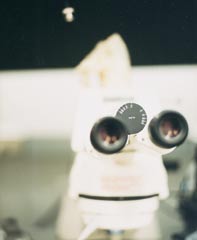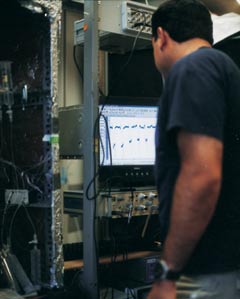So that’s how nerve cells transmit information so quickly
By Mitzi Baker
Photographs by Leslie Williamson
 |
|
Richard Tsien sheds light on neurotransmission with a microscope he uses in the dark. The black curtain blocks rays that wreck measurements. |
|
Kiss-and-run. While the term brings to mind spouses being dropped off at a commuter rail station, neuroscientist Richard Tsien, PhD, uses it to explain a newly established method that neurons use to relay information. Tsien’s new finding overturns long-held beliefs about how the nervous system works and helps explain how neurons in the brain can transmit information with lightning speed.
Neurons communicate with each other by releasing chemicals across the junctures that separate one nerve cell from another – the synapses. “The synapse is one of the underexplored frontiers of neuroscience,” says Tsien. While scientists know that individual neurons release chemicals – known as neurotransmitters – to communicate to others across the synapse gap, not a lot is known about how the nerves move these neurotransmitters from inside the cell out into the synapse.
Until now, textbooks explained information transfer across a synapse this way: Inside a neuron, membrane-enclosed bubbles carrying information-relaying neurotransmitters fuse with the neuron’s surface membrane and expel their contents into the synaptic cleft, the narrow space between transmitting and receiving nerve cells. The bubbles, known as vesicles, can then pinch off again and reform – a process that takes at least a few minutes. The problem with this theory is that it fails to account for the high rate of information transfer in the brain, where the numerous tiny neurons might have only 30 active vesicles each.
“We followed a different hypothesis,” says Tsien, the George D. Smith professor of molecular and genetic medicine. Tsien and his team explored an unproven mechanism that neuroscientists recognized but didn’t take seriously. “It was heretical enough that the vast majority of neuroscientists didn’t believe it.”
 |
|
The right tools: The Tsien lab uses this scope to study brain slices. |
|
Tsien’s theory, known as “kiss-and-run,” envisions no collapse of the vesicle at all; instead, a vesicle opens briefly to let some neurotransmitter out and then closes and can quickly be readied to release more neurotransmitter soon thereafter. Tsien, along with Alexander Aravanis and Jason Pyle, students earning MD/PhDs in the Stanford Medical Student Training Program, have provided the first evidence of this type of release. Their findings were published in the June 5, 2003, issue of Nature.
Neurobiologists have traditionally used the retina of fish for their studies of neurons because these neurons are big and easy to handle. Much of what we know about how synapses work comes from these specialized fish neurons, which can contain a million vesicles each. But the environment in the fish retina is quite different from that found in the human brain, where neurons are compact and abundant, says Tsien. His team used rat brain neurons, cells more similar to those found in the human brain, to observe transmission across the synapses.
The traditional method of studying synapses relies on monitoring the cells’ electrical signals, a method that is cumbersome and indirect. “We decided to take the bull by the horns and study brain synapses directly,” Tsien says.
So his group did something that hadn’t been done before, which is to study the vesicles individually and watch them release their contents in real time. They devised a method that trapped fluorescent dye within a vesicle so they could track that vesicle’s life cycle. While viewing the vesicle under the microscope, the researchers directly measured the decrease in fluorescence as the vesicle released the dye.
 |
|
Recording studio: Watching a recording of neuronal electrical activity. |
|
Top-notch equipment was key to the group’s success. Medical students Pyle and Aravanis, both of whom have studied engineering, used their skills to fine-tune the microscope and adjust the camera and data-acquisition processes to work efficiently. “They cleaned up the optical system so that the signal-to-noise ratio was really amazingly good. That’s what allowed the signal to be detected,” says Tsien.
“There is a strong component of physics and engineering meets biology here,” he adds. Although no one has been able to track a vesicle’s fate in real time before, Tsien credits Stephen J. Smith, PhD, professor of molecular and cellular physiology, for laying the groundwork to study single vesicle dynamics using fluorescent dye.
The trio’s findings provide the evidence that the proposed kiss-and-run mechanism really does work in neurons taken from the brain; that a vesicle can open up, recover within a second or two and then fire again. The team also found support for the older hypothesis for vesicle transmission. Nerves seem to use both methods.
“That re-use, that ability of a vesicle to open up a second or third time is what we think makes vesicles much, much more efficient than previously thought at releasing neurotransmitter over and over again,” says Tsien.
Tsien says that there remain many challenging questions to answer. For now, he says, their results go a considerable way toward explaining how tiny synapses in the brain can transmit a vast amount of information very quickly. “I wouldn’t say that every mystery is completely cleared up, but it certainly helps that vesicles can be re-used,” says Tsien. “I don’t want to claim that this is the end of the story; it’s really the beginning.”
Comments? Contact Stanford Medicine at

